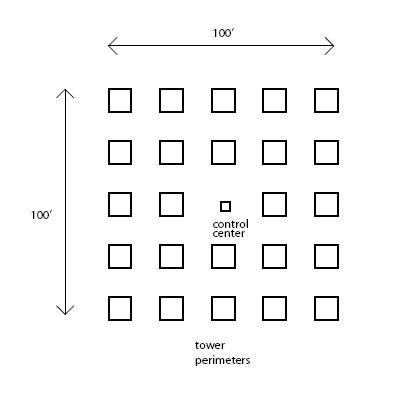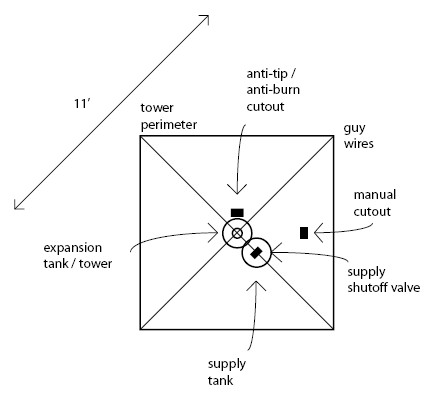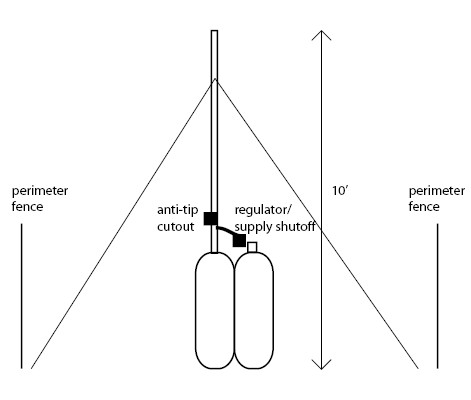
Components



Bill Codding
http://www.4bc.org/burninator
email: burninator@4bc.org
The Burninators have been part of Burning Man's very-large scale fire art for several years, thanks to the Burninator Crew in conjunction with generous grants from the Burning Man organization. The Burninators are very large scale propane-driven installations of flame towers, designed to be powerful up close and yet visible from great distances. Computer control allows them to be canvasses for patterns of flames 'painted' onto the desert, all safely controlled by participants. The Burninator II, built for the 2006 event, took the idea of fire art and made it really large - playa-scale large - for the first time. A quarter-mile line of flame towers was built along the axis of the city; sequencing software created patterns of fire visible from as far as 10 miles away. The next year, 2007, saw an installation twice again as big - the Burninator X, laid out in the shape of a cross, covering almost a half-million square feet. Participants could see the scale of the installation from every corner of they playa, and also loved the visceral experience of standing directly in the lines of the towers and letting the patterns of explosions go over their heads. The Burninators became well-known Burning Man installations, certainly in part because they were hard to miss!
It would be great to make the Burninator even larger...however, there is a different dimension that can be fully exploited in a different way - intensity. Imagine all the towers of the Burninator collapsed onto a smaller grid, packed into an area that the participant can enter - an installation with the same power of massive flames, but completely surrounding the participant....
The move from scale to intensity is a direction in which the Burninator installations need to go. Taking the same large number of towers that were previously spread over a larger and larger area and collapsing them into a small field of fire may sacrifice the scale of the installation, but will allow it to become truly overwhelming. The flames will still be visible from everywhere in the city, not as a set of patterns but as a compact, bright area of flame...but the most intense experience will come from approaching and entering the installation to feel all the towers going off all around. The noise and visceral effects of being able to walk through the grid will again take the feel of the Burninator to a new level. From inside the grid of towers, the explosions, noise, and heat will be completely immersive.
I have always liked the use of technology to create art, and control large-scale fire in safe and creative ways. I feel that the beauty of fire, and art created with fire, is greatly enhanced by the power inherent in the flames, and especially by the respect and sense of fear that come along with that power. These are the aspects that I now want to fully exploit by sacrificing scale for greater intensity.
As in past years, I will try to get the attraction that spectators feel to morph into participation (and to mitigate their fears), by giving them the power to control the large-scale flame art themselves. And, as in 2007, I will try to use that attraction to open the door to education about the environmental considerations of fire art and carbon-based fuels.
Physical Layout
Components



The interactivity of this piece will again take on two forms: allowing spectators to safely operate the installation, and educating about carbon emissions.Spectator operation
The crew heard many times in the past years from participants who said that they couldn't believe they were allowed to approach the control center, much less use it themselves to control the flames; this has always been one of the greatest appeals of the Burninators. As before, the idea is to leverage technology to make fire art safely approachable in a way it hasn't often been before.
And again, the methods of interaction with the control center will be re-thought and enhanced for use with a grid-based layout. The main interfaces will be a proximity sensor board, a simple computer GUI, and cards which when scanned will create patterns of fire.Green Education
But...how to make interactive fire art compatible with the idea of the greening of the event? The installation will serve to help educate the participants about carbon emissions, carbon credits, propane and carbon-based fuels. Signage and the user interface at the control center will:
- make the connection between the quantity of fuel that users see burning and common household usage
- educate about the world's supply of carbon based fuel and the rate that it is being used
- provide an insight into the inner workings of the carbon credit market and the organizations behind them
- ask people to examine the impact of using carbon-based fuels for purely artistic purposes, and the tradeoffs of 'discretionary' versus 'necessary' uses of energy and carbon fuels
A significant portion of the previous Burninators will be used to create this year's Burninator GRID.The sequencing and control software was rewritten in the past years to be more generic to the control hardware and the installation size. This work will continue, with a software package that is now reusable for other fire art projects.
- Most of the towers, valves, and wiring harness are already constructed and are re-useable; only a few components will need to be rebuilt for this year's installation.
- The electronics are now more mature and well-tested.
- The programming was done with different layouts in mind - coding in the grid-based patterns will take less time than previous years.
- The installation and construction will follow the practices refined over the last two years.
Crew
The Burninator crew has a reputation for safe, on-time delivery of the projects in the proposals. Again a solid crew will be necessary for construction, safety, electronics, and operation. Most of the necessary people for the electronics, the safety, the construction, and operation have already made commitments. We will also be seeking others for an expanding team.
Crew Roles (several may be done by each person):
- artist
- electronics
- mechanical assembly (multiple)
- layout & perimeter
- safety during operation (multiple)
- operation (multiple)
- maintenance (multiple)
- cleanup (multiple)
Timetable
The timetable should look like this:
- 15-Mar: requisition and purchasing begin
- 01-May: construction begins
- 30-Jul: programming is complete, sequence development starts
- 17-Aug: begin on-site construction (earlier if possible)
- 20-Aug: trenching
- 28-Aug: on-site construction complete, testing begins
- 31-Aug: event opens, performances start
- 05-Sep: last performance
- 10-Sep: cleanup complete
The safety systems for the previous Burninators have advanced the idea of safety for large scale fire. New ideas on both operational safety and advances in the mechanical and electrical control of propane on a large scale system were implemented, including:Also, as in previous years,
- instant shutdown mechanisms
- tip sensors
- automatic burn sensors with shutoff mechanisms
- remote control
- RFID identification of permitted operators
- electronic and computer lockouts of control mechanisms
The existing safety plans of the Burninator II and X will be enhanced for the new grid layout. The full safety plan will be submitted and discussed before the event, with the safety procedures, mechanisms, and diagrams. Burning Man's safety and fire contacts can testify as to the Burninator crew's attention to safety, and safety record.
- components are propane- and pressure-rated
- valves and other components are industrial-strength
- a trained safety crew is always present
- spotters are present to ensure towers are intact
- a safety vehicle is present to reach towers immediately
- towers have perimeters and are at a safe height
- the equipment is tested and inspected daily
- the system is locked out except during performance times and when crew is present
As noted above, most components from the previous Burninators are reusable. These estimates reflect recycled and already available equipment and material as possible. As always, the most significant portion of the cost is the propane.
Propane
Transportation
Gas/Diesel
Electronics
HardwareSafety
- tower repairs
- valve rebuilding
- hose
- fittings
- igniters
- tank heaters
- wiring and connectors
Generator RentalControl Station
- 25kVA generator
- power box
- temp cable
- insurance
Carbon Offsets
- platform
- fence
- lighting
- educational material
(*): slightly larger than the Burninator X, accounting for increased fuel costs; also includes tank rental
(**): fuel for creating and running the installation, not transportation
(***): United Rentals Reno
(****): carboncounter.org, climatetrust.org
This estimate does not include:
- heavy equipment costs: 3 hrs trenching, dust mound dispersal
- labor costs
- programming costs
- cost of hardware that will be loaned
- cost of any hardware that will be re-sold and costs recuperated
- costs covered by the artist
- water
- t-stakes and fencing
- fire extinguishers